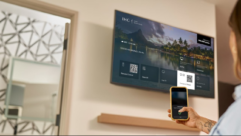
The Apple iPhone has Lost Its Mojo
Sep 17, 2012 10:10 AM,
By Jason Bovberg
How Google and Microsoft are out-innovating the smartphone stalwart.

Apple iPhone 5
Did you tune in to the Apple iPhone 5 event last week? I’m sure a lot of people did, and I’m sure a lot of people were expecting some pretty amazing stuff. Apple always delivers pretty amazing stuff. Right? There’s really no question that Apple has been the leader in the consumer electronics arena thanks to its innovation and its “in crowd” gloss. But there are challenges coming from all corners now—in both the smartphone and tablet-computing markets—and so the time was right for something new and groundbreaking. The previous iPhone, the iPhone 4S, was more about evolutionary upgrades, so expectations were also high in that regard; after all, this was a full number update to version 5. What would the reliably forward-thinking Apple reveal?
Not much: a slightly larger screen, 4G connectivity, minor design changes, faster chip, and longer battery life.
Yes, Apple fans will gobble up the iPhone 5. Preorders sold out in minutes, and Apple Stores will see their usual long lines. But—as the Twitter conversation that took place during the event can attest—these aren’t the kinds of updates that are going to keep Apple at the front of the pack.

Samsung Galaxy
And suddenly the rest of the field is more visible.
First, you have to take a look at the Google Android universe of smartphones. After all, Android phones are outselling iPhones by a wide margin, and have been for some time. You might consider Apple’s recent courtroom victory over Samsung to be some kind of vindication for Apple, but it has also highlighted some hard truths about the evolving market position of the Cupertino powerhouse—namely about price. To many, the whole drama suggested that Apple was feeling threatened by the rising dominance of Android, which is increasingly seen as a smartphone option that offers features and functionality that are the same as—and even better than—the features of the iPhone—for a cheaper price.
For one thing, Android smartphones have had many of the iPhone 5’s “new” features for quite some time. The new 4in. screen remains small compared with a lot of the Android competition, which offers screen sizes up to 5.5in.! The new, highly regarded Samsung Galaxy S III features a 4.8in. screen, the Motorola Droid RAZR M and the HTC One S feature a 4.3in. screen, and the RAZR MAXX ups the ante to 4.7in. The Galaxy Note cranks it up to that almost preposterous 5.5in. And HD resolution is common in the Android smartphone realm. Even with the introduction of the iPhone 5, Apple is looking a wee bit inadequate, in comparison.
In a similar vein, Apple might talk up the iPhone 5’s impressive A6 processor, but details are sparse, and the talk rings a little hollow in light of the lightning-fast dual-core processing speeds across the smartphone market. Battery life was a key part of the iPhone 5 announcement, but its claims aren’t terribly impressive compared with other alternatives. And don’t forget: You can’t remove the iPhone battery, but most of its competitors let you replace the battery—highlighting one of the key disadvantages of the insular Apple approach. The iPhone also doesn’t support wireless battery charging, which is a fabulous new innovation that finds Apple playing “follow the leader.” It’s understandable why more and more consumers are looking for alternatives: Apple can claim fewer and fewer reasons to justify its premium price tag.
But when we’re talking about alternatives to the iPhone, it’s strange to talk only of the Android system, because the two OSs are extremely similar. They both use that familiar “whack-a-mole” interface that just randomly throws app icons across the interface—an interface that spans all kinds of iOS devices, including the iPod and the iPad, but an interface that lacks elegance.
A smartphone OS that’s poised to make some noise in this same-old-same-old environment is Windows Phone. Microsoft was a regrettably late player in the smartphone market, and many thought it was doomed. What it really needed was a truly great, flashy phone to highlight its advantages—and it finally got that in the Nokia Lumia 900. And now with Windows Phone 8 on the horizon, Nokia is poised to nudge Windows Phone even higher into the market.

Nokia Lumia
The Lumia 920 is a truly gorgeous phone, presenting a stark contrast to the iPhone that Android phones just don’t offer. Multi-colored and sleek, and offering a 4.5in. display, the Lumia 920’s best advantage is the Windows Phone 8 OS itself, which has matured into a satisfying, uber-customizable user experience. I sometimes make a habit of wandering through the smartphone selection at my local consumer-electronics superstore, and over time I’ve seen increasing numbers of customers checking out the Windows Phone alternative. Microsoft may have severely hobbled itself by early missteps and a slow start, but its partnership with Nokia and the flashy rise of the Lumia could finally bring some success to a severely underrated platform.
And that platform is on the brink of breaking out in more ways than just the smartphone. We’re about to see the same kind of Metro-style interface design extend to Microsoft’s tablet-computing OS, Windows RT, as well as the new version of Windows—Windows 8—on the traditional and touchscreen desktop. A major benefit of the Windows Phone platform is already that it fits and syncs into home Windows environments quite effectively, offering a common platform, and that will be even more the case with Windows 8 and Windows Phone 8. And all kinds of manufacturers will be partnering with Microsoft to make this synchronicity a reality.
I mentioned Apple’s “insular” nature—it’s something that has always annoyed me about the company. Everything about the iPhone is proprietary. You’re locked in. I far prefer a marketplace that is open to innovation and competition, and now that a multitude of players have caught up to and even surpassed the iPhone in capability and design, that insular nature is coming back to haunt Apple. And in my opinion, the rest of us win.










